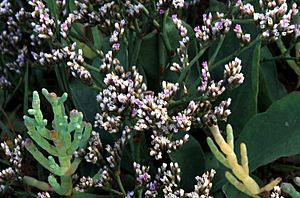Limonium californicum facts for kids
Quick facts for kids Limonium californicum |
|
|---|---|
 |
|
| Scientific classification | |
| Genus: |
Limonium
|
| Species: |
californicum
|
| Synonyms | |
|
Limonium californicum var. mexicanum (S.F.Blake) Munz |
|
The California Sea Lavender (Limonium californicum) is a beautiful plant often found along the coast. It's also known as Western Marsh Rosemary. This plant is part of the Plumbaginaceae family, which includes other sea lavenders.
You can find this plant growing naturally in western North America. Its home stretches from Oregon all the way down to Baja California in Mexico. Sometimes, you might even spot it in Nevada and Arizona.
Where Does California Sea Lavender Live?
This plant loves coastal areas. It grows well on beaches, in salt marshes, and in coastal prairies. It's also happy in other sandy places where the soil is salty or alkaline, like dry lakebeds (called playas). These tough conditions are perfect for the California Sea Lavender.
What Does California Sea Lavender Look Like?
The California Sea Lavender is a strong plant that lives for many years. It grows from a woody underground stem called a rhizome. This helps it spread and survive.
Its leaves are thick and feel a bit like leather. They are oval-shaped and can grow up to about 30 centimeters long, including their stems (called petioles). These leaves grow in a circle at the base of the plant, like a rosette.
The plant's flowers grow on a stiff, branching stalk. This stalk can reach about 35 centimeters tall. It holds many clusters of small flowers. Each flower has brownish-white outer leaves (called sepals) and petals that can be lavender or almost white.

